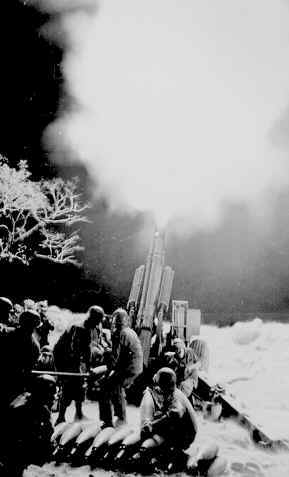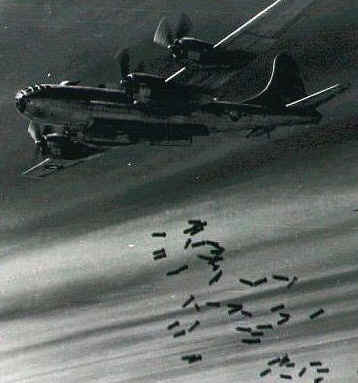Aircraft
|
Aviation had little effect on the
outcome of the surface battles of World War I because it was still in
its developmental infancy. World War II was totally
different. The 1930s had brought a rapid advance not only in the design of bombers but in the theories and tactics of how they were to be
used. In particular, the Germans had developed their infamous
Blitzkrieg tactics in the Spanish Civil War where they were given an early chance to test many of
their new ideas in combat. The tactics developed by the Axis and
Allies during the course of the war would prove to bring about an
entirely new era of warfare. Even now, air support plays a vital
role in warfare.
|
 |
Broadly speaking, the bomber of the Second World War was employed strategically or
constructively. "Strategic" attacks focused on
adversary's communications, factories, sources of supply, and fighting
enemy forces. "Constructive" attacks were intended to
undermine support for the enemy and focused on the civilian
population.
|
| Strategic bombing demanded defensive, not offensive, tactics due to the Luftwaffe and
highly maneuverable Japanese fighters. The bombers employed to mount the Allied strategic air offensives were continually forced to evolve different tactics to counter
air, sea, and land defenses.
In Europe, American bombers flew during daylight hours (for more precise bombing
runs) and, thus, encountered different problems than their British counterparts who flew at night.
Contrary to original expectations, American bombers required fighter escorts to prosecute sustained attacks against heavily defended
targets. Until long range fighters became operational in early 1944, American bombers had to rely on their own armament and employ formations which gave maximum mutual defensive firepower.
|
 |
As the war progressed all kinds of Electronic warfare devices were brought into play to confuse German radar and thus misdirect the German night-fighters scrambled to intercept the bomber-stream. "Spoof raids" were also started to draw them off from the bomber-stream.
Non-operational aircraft were assembled and flown towards the target area before the bombers. If they timed it right, they could turn back after the fighter
defenses had been committed to attacking them but before they could themselves be caught, leaving the main stream of bombers able to avoid attack.
|
 |
Before the war strategic air warfare enthusiasts had overestimated the effect of air ordinance on urban and industrial targets. They had assumed erroneously that air attacks would easily break an enemy people's will to continue a war. Both in Europe and in Japan repeated air attacks and many tons of conventional bombs were required to neutralize war production facilities.
(Germany actually increased its war production during the months of the
Allied air attack by utilizing its tremendous economic potential and
displaying good ability to repair and disperse its factories. However,
war requirements multiplied even more swiftly than production, with the result that, beginning in December
of 1944, all sectors of German
economic life were collapsing.)
|

With a limited economy crowded into a few industrial cities and without adequate air defenses, Japan was highly vulnerable to air assault. Nevertheless, strategic bombing had to await the deployment to combat of the new B-29 aircraft, which had a range long enough to reach Japan from available bases. Hurried into combat from airfields in western China,
the air
commanders began using day precision bombing from high altitude as they
had in Europe, but this produced disappointing results due partly to
strong winds at such a height. Thus, the bomber tactics of the
USAAF attacking Japan with the new B29 also underwent a number of
radical changes. A suggestion that the bombers use incendiaries
proved to work. These "Fire Raids" ended up inflicting
greater material damage on Japan than the two atomic bombs. |
|
"It seems clear," stated the United States Strategic Bombing Survey, "that air supremacy and its later exploitation over Japan proper was the major factor which determined the timing of Japan's surrender and obviated any need for invasion."
|

Copyright © 2000 [Matt Wilhelm]. All rights reserved.
This page was last updated on 07/25/00.
|